Author Archives: jlammerts
Three Tips for a Greener Wedding Breakfast
A guest post by Kelly Peterson
If you’re planning a sustainable wedding, you may be wondering how to tackle your wedding breakfast. Although wasted food is one of the most common offenders to carbon footprints at weddings, there are plenty of ways to ensure your guests are satiated in a more eco-friendly fashion.
Here, we share three golden tips for a greener wedding breakfast.

Opt for local, seasonal produce
Whilst some wedding venues require you to use their in-house caterers, others allow you to choose your own. Having control over your catering is a valuable tool when it comes to ensuring it’s as green as possible.
Opting for local caterers who prioritise sustainability in their own businesses, and use fresh, locally sourced produce is the best way to reduce any carbon emissions from transporting food ingredients. If they can, opting for organic produce also reduces the environmental impact of your produce.
Supporting small businesses is a great option, as many are more eco-friendly than larger chain catering companies. Look for green flags such as using free range, high welfare animal products, organic fruits and vegetables, and sustainable packaging. Not only will using seasonal produce make your wedding breakfast greener, it will taste absolutely delicious as well.

Consider alternative options
There’s no rule that you have to have a three-course meal for your wedding breakfast if you don’t want to. There’s loads of creative, fun options that can not only add a unique quality to your wedding but can also help reduce the carbon footprint of your day. Food trucks, grazing tables, buffets and barbeques all help to ensure there’s as little food wastage as possible throughout your wedding breakfast.
The beauty of food trucks is that each meal is made to order, and any leftover produce is likely to be used for following events by the supplier. Adding more vegetarian or vegan options, or even having a meat-free wedding breakfast if that suits you, is another brilliant way to reduce the overall environmental impact of your feast.

Be smart with your add-ons
From your alcohol to your wedding favours, each small element of your celebration has the potential to further boost the eco-credentials of your big day. Try to use sustainable brands, offer fewer dessert options, opt for a smaller wedding cake and use eco-friendly wedding favours. Consider what your guests will actually use, rather than what’s traditional – for example, edible favours are less likely to be left behind at the end of the night.
By making multiple small changes to your offerings, you’ll find you reduce the environmental impact of your entire wedding. If you have to use your venue’s caterers, ask them questions about their food waste policy, as well as their other internal sustainability policies, to ensure their ethics align with your own.
Keep your vision in mind
Ultimately, hosting a greener wedding breakfast is all about making multiple small changes to your menu, to ensure that your sustainable values echo through each element of your meal. By keeping your eco-friendly vision in mind when booking your venue, caterers and suppliers, it’s more than achievable to enjoy your wedding breakfast at a smaller cost to the environment.
Why you NEED a wedding planner!
After having planned, designed and produced close to 200 weddings, I’d like to share a bit of advice with all newly engaged couples: please watch my LinkedIn video!

Lauren and Darren: An Elegant Affair at Villa Montalvo
When these two decided to tie the knot, they were looking for a venue with character, something special and unique, and they turned to my company, A Day Like No Other, for help. I had an idea, and they loved it: Villa Montalvo in Saratoga, a grand historic mansion surrounded by a manicured park – a really unforgettable setting. And so we begun to put together the myriad details over nearly a year of planning time. Finally, the Great Day had come – the Sunday of Labor Day weekend.

After her hair and makeup session (by Nicole’s Vanity), the bride got into her diaphanous, lace-and-tulle dress, and the groom dressed up as well…

… with photographer Julia of Danny Dong Photography capturing all these precious moments.
The wedding flowers in the bride’s favorite muted Fall colors (by Laurel & Vine) had arrived…

… and it was time for the couple’s First Look.

The Italianate Garden at Villa Montalvo with its “Love Temple” was the perfect backdrop for many beautiful portraits…


… as well as the site for Lauren’s and Darren’s wedding ceremony under an elaborately decorated chuppah.

Soon, guests were arriving (via shuttles from Corinthian Ground Transportation)…

… and musicians from the Lucky Devils Band began playing as guests were being seated. Rabbi Dana Magat conducted a traditional Jewish wedding ceremony.

Just married! Mazel Tov!

And off to more photos…

… in the beautiful park surrounding the Villa. Guests were invited to cocktails in the Spanish Courtyard.with a full bar (by Best Beverage Catering).

Meanwhile, the teams of A Day Like No Other, of La Bocca Fina Catering and Laurel & Vine florists were busy putting the finishing touches on the dinner setup on the front verandah…



… under string lights installed by Brilliant Event Lighting.
Guests were treated to delicious dishes…

… and everyone had a good time – especially the newlyweds!

After dinner, guests were invited to a mouthwatering dessert buffet and ice cream from Scoop Microcreamery.


Following dessert, there was no holding back on dancing. Beginning with Lauren and Darren’s First Dance as a married couple…

… to music by the Lucky Devils Band…

… followed by the traditional, exuberant Hora Dance, with the couple being hoisted up in the air…

… and culminating in an epic dance party for everyone. When it was finally time to say good-bye, the newlyweds’ send-off was equally grand: with guests cheering on them with bubbles and glowsticks as they were leaving…

… in a gorgeous vintage limousine (by Elegant Journey) into their married bliss.
Again, congratulations and Mazel Tov to you, Lauren and Darren!
Let your next party take flight – in a historic airport terminal!
I know – you think that’s a totally crazy idea. I would have said the same, until today, actually. Despite having lived in San Francisco for twenty years, this part of the City’s history was completely unknown to me: an international airport terminal on Treasure Island, built in the late 1930s as a gateway for PanAm flights to the Far East. The terminal and two adjacent hangars is all that is left from these glory days… the days of the Golden Gate World expo!
So here is your history lesson:

Treasure Island is actually an artificial island in the SF Bay! In 1937, the then-revolutionary Bay Bridge was built, and in celebration of this engineering marvel, San Francisco hosted a World Exposition – on Treasure Island – and built an airport right there…

… complete with tower!

Everything is still original in its elegant Beaux Arts style…

… reminiscent of a bygone area when air travel was an exquisite luxury.
The interior features an enormous mural by artist Lowell Blair Nesbitt and authentic terrazzo flooring.


The space can easily accommodate up to 400 guests, and the heart of the party is a gorgeous period piece of a bar, with red velvet draperies and a grand piano…
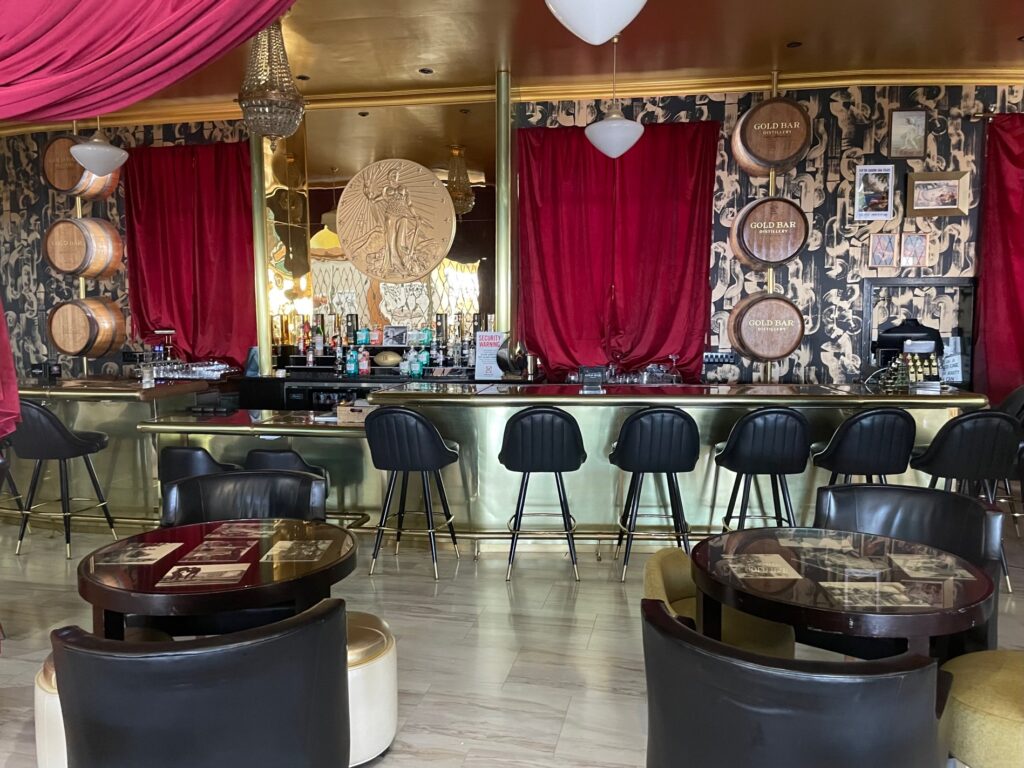
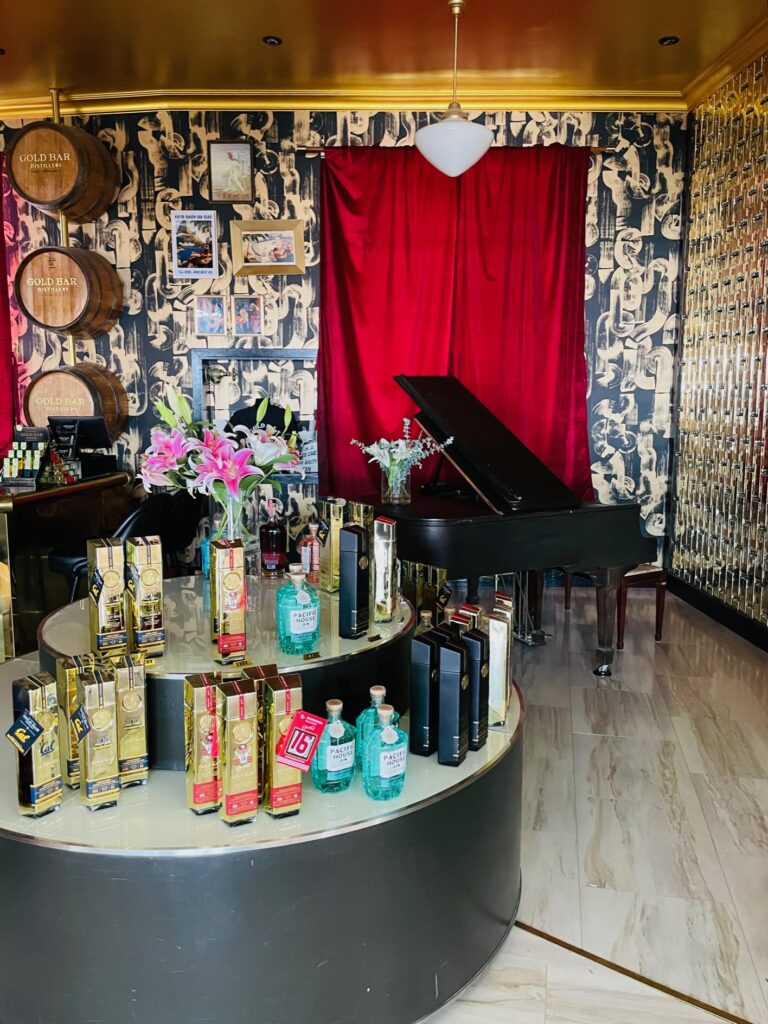
… complete with a resident peacock!

I can literally see the space transformed into its previous glory – Great Gatsby would have loved it! So many possibilities… and – did I forget to mention? Parties can go on until 2 am!
At Golden Hour, guests are treated to spectacular sunsets over the City and the SF Bay – with a front row seat in the bar, looking out the back windows… the SF skyline is just on the other side of the Bay, and the ferry terminal is literally across the street. Just perfect.

Get ready to plan your next party there!
The Allure of Apricot: Pantone Color of the Year 2024
I can hardly think of any color that’s more uplifting, positive and summery – in short, any color that would make me smile and feel happy – as apricot. We all need this emotional boost right now, so: Thank you, Pantone! Spot on!

Drumroll…. here it is: “Apricot Crush!” It is SO chic…

… and it can be combined in so many ways – both within the color family, from pale peach through coral and terracotta…

… accented with complementary hues – greens, blues, purple – AND grounded with soft neutrals, especially a soft grey.

How I know that? Easy – at A Day Like No Other, we have worked with this beautiful color many times over the years (and every time in a different way). Want to see?

For a styled photoshoot, introducing the newly renovated ballrooms in the Westin St. Francis hotel in San Francisco, we offset the central new color of the ballrooms – silvery grey – with apricot, peach and coral. I think it’s a stunning combination!

Even the wedding cake played along!

Well – convinced? But this is only the beginning! For a recent late-summer wedding, we combined apricot with sage green for a fresh, summery look:

For a fall wedding last year, we played up the vibrant side of apricot with orange, rust and fiery red hues in the towering centerpieces …

… and the softer, “peachy” side of the color with shimmery napkins, champagne tablecloths and metallic gold accents.

We also added a touch of pale blue (in the water goblets) – actually inspired by the color combination of the bride’s favorite flower, the Bird-of-Paradise, which was the star in all floral arrangements.
Then, there is, of course, apricot at the center of a palette of sunny, warm hues, like in this outdoor summer wedding a few years back:

… here combined with bare wooden harvest tables and ivory runners (= the neutral hues to ground the whole riot of colors), metallic gold and terracotta for the napkins. (Photo credit: Danny Dong Photography).
You’d rather go more subtle with apricot? No problem: here combined with ivory (flowers), silver (foliage) and a pale mint green (bridesmaids dresses). Pretty, yes?


Didn’t I promise more, bold combinations…. like violet and purple? Look here and be stunned:

As you can see, the combination with deep purple and pale violet makes the apricot “pop” even more! The “neutral” color in this wedding was the navy blue of the groom’s and groomsmen’s suits.

A few more inspirations, here with the light green of hydrangeas…


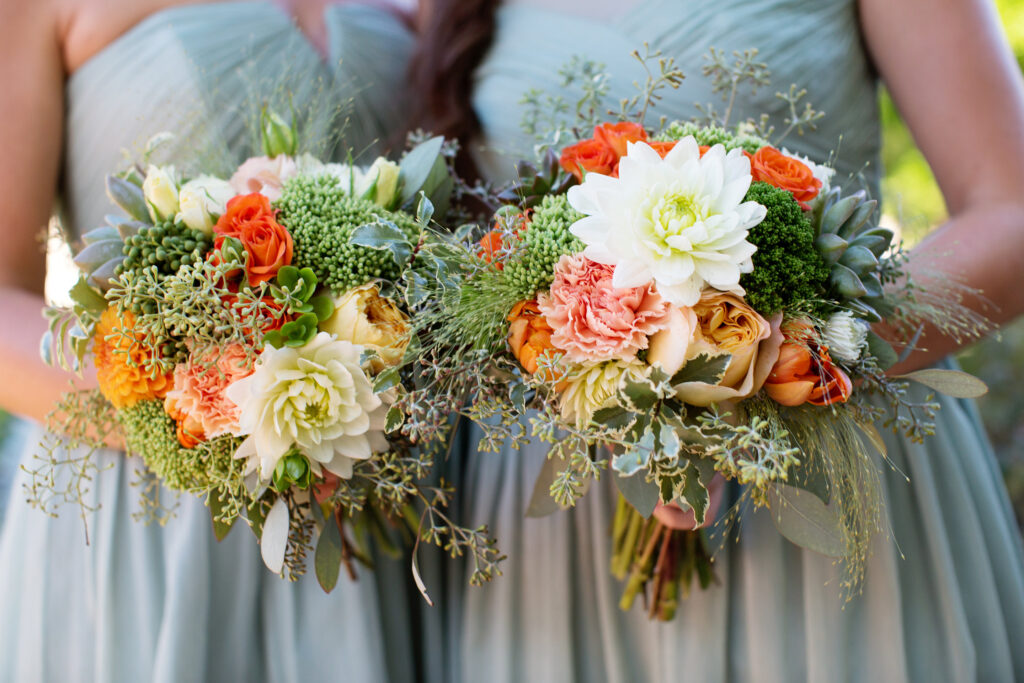
I hope you are now as happy about this new Color of the Year as I am! Off to a joyful, vibrant and uplifting wedding season 2024!
Mariko and Phillip: Glamour and Urban Chic
We all know how much San Francisco has to offer – Golden Gate Bridge, historic mansions, the SF Bay, gritty-industrial buildings, the most beautiful Beaux-Arts style city hall in the nation… What if you are getting married, and you can’t decide where in San Francisco? Then you do what Mariko and Phillip did: all of the above! A ceremony in City Hall,

….followed by a reception at Gallery 308, an industrial space overlooking the SF Bay. Their guests even got treated to a little sightseeing tour to historic Ghirardelli Square, on the way from ceremony to reception. That all made for complex logistics – that was what they had my wedding planning company, A Day Like No Other, for – but it was all well worth it.
Mariko’s day began super early – at 6 am! – so she would be ready for her First Look at 9 and her ceremony at 10. Her photographer Kristen Murakoshi of Studio Ma was already waiting for her and for groom Phillip at City Hall. Mariko brought her elegant bridal bouquet in muted summer colors and cascading tiny orchids (all floral decor by Green Petal Designs).

Then it was time for many, many photos – SF City Hall is just gorgeous! And so was our couple…



Soon enough, the first wedding guests were arriving (in shuttles by Corinthian Ground Transportation), officiant Maggie Beretz prepared for the ceremony, and pianist Lara Garner began playing prelude music as guests found their seats. The ceremony took place on the Grand Staircase under the soaring rotunda of City Hall.

It doesn’t get much more grandiose than that… And here they are, “just married!”

Time for a kiss – one of many…

While the wedding guests were taken by shuttle on a mini sightseeing tour to historic Ghirardelli Square, the newlyweds had time for many more photos in and around City Hall.



From there – off to Fort Mason, to their lunch reception for 200 guests at Gallery 308, an industrial space overlooking the SF Bay.




Exactly Mariko’s and Phillip’s colors! And their style – they had asked me for a design in ’70s style and colors and had chosen their invitations accordingly:

… and for their table flowers, they wanted Ikebana style in exactly these colors. You think that these design ideas are too disparate to be integrated into one cohesive style? Think again! We made it happen. Here are the beautiful centerpieces by Green Petal Designs.

When the newlyweds arrived at their reception venue, the venue staff had set up their tables and chairs, the catering staff of Smokin’ Yankees BBQ under the leadership of Bekah Juencke had laid the tables with linens, napkins, and elegant china, flatware and glassware from Hensley Event Resources; with paper cranes folded by the couple themselves for good luck;

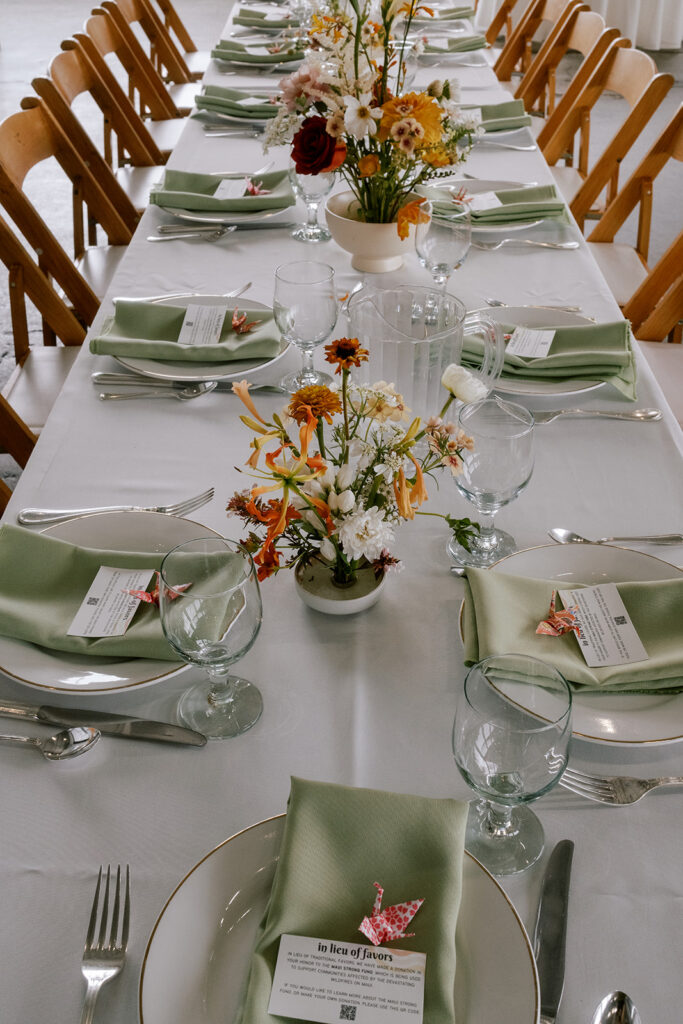

the centerpieces were in place,

delicious BBQ food was being served, bartender Will Mar and team had the bar in full swing, and Travelin’ Joe’s coffee and waffle bar was open, too.
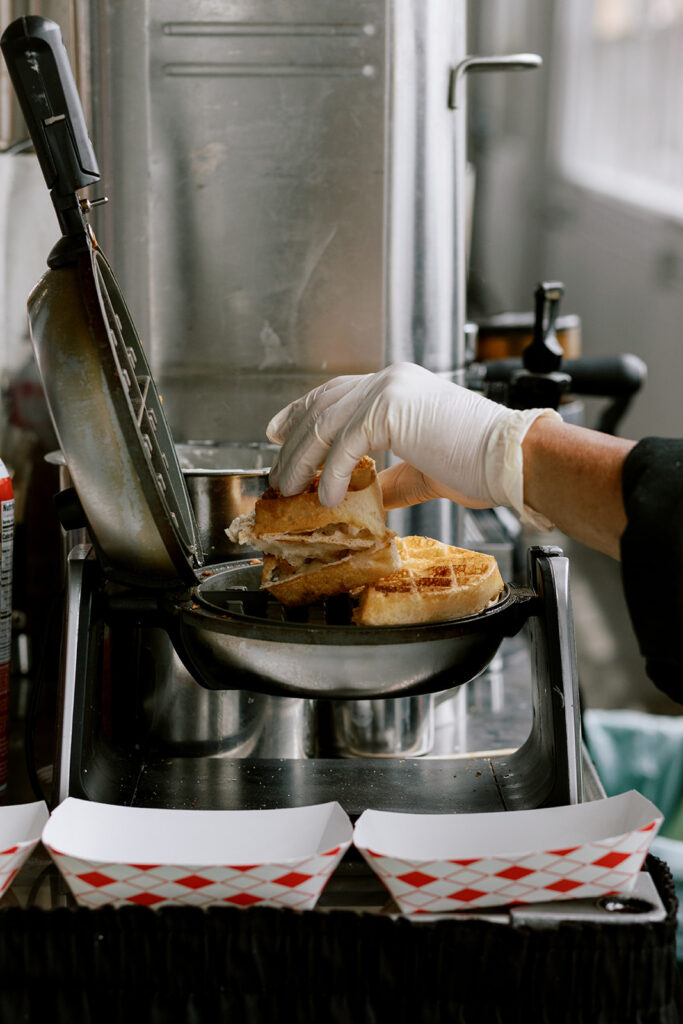
DJ Ron Israel of Spotlight Occasions had the music going, and a delicious dessert bar was waiting for the guests as well.

The whole reception was quietly and efficiently orchestrated “behind the scenes” by the two experienced production managers from A Day Like No Other, Nimy and Myrtle.

Bride and groom were happy!

After the festive luncheon, Mariko and Phillip shared their First Dance as a married couple…

…. and that brought their guests to the dance floor, too.
When the festivities concluded in the late afternoon, everyone agreed: this was one unforgettable party!
Keep dancing and celebrating on your shared journey, Mariko and Phillip – with our best wishes on your way!
The Wedding Invitation Dilemma…
As a wedding planner, I am asked for advice on a multitude of wedding-related decisions, but one recurring theme is: “what should we do for invitations?” Two decades ago, the answer would have been simple and straightforward: have them designed and printed in a stationery store. Period.
Obviously, that has changed – there is now so much more to choose from! In recent years, many of my clients have opted for online invitations (an unthinkable breach of etiquette still not too long ago…) which have become attractive and very convenient AND increasingly accepted. Be it Paperless Post or (my favorite) Greenvelope – the option of including all necessary information and even photos and music into a wedding invitation, and to integrate RSVPs and meal choices in that same process, is definitely attractive.
But even clients who choose printed invitations have a decision to make – and that is: custom or template?
Honestly, the foremost consideration here is price. Custom invitations are expensive – no wonder, considering how much talent, creativity and work go in there! Here are a few examples from previous weddings of mine and from styled photoshoots.



Custom invitations for a styled photoshoot by Monks of Age Calligraphy

Custom table numbers for clients from Southern China, showing classical painterly motifs from their native country, by A Day Like No Other

So, now you see the whole range of custom invitations – from traditional to modern, from romantic to whimsical… Is it possible to achieve a similar effect with online templates? You will be surprised – even I as a real “design purist” have to admit that YES, it is possible to achieve something quite unique and beautiful by using premade designs and customizing them. My all-time go-to website for this purpose is minted.com with its myriad options, some of which I will show you in the following – real ones that have been used for previous weddings that I designed. (And the best thing: you, the clients, can get discounts at minted.com as well!). Here we go:



of the South of France
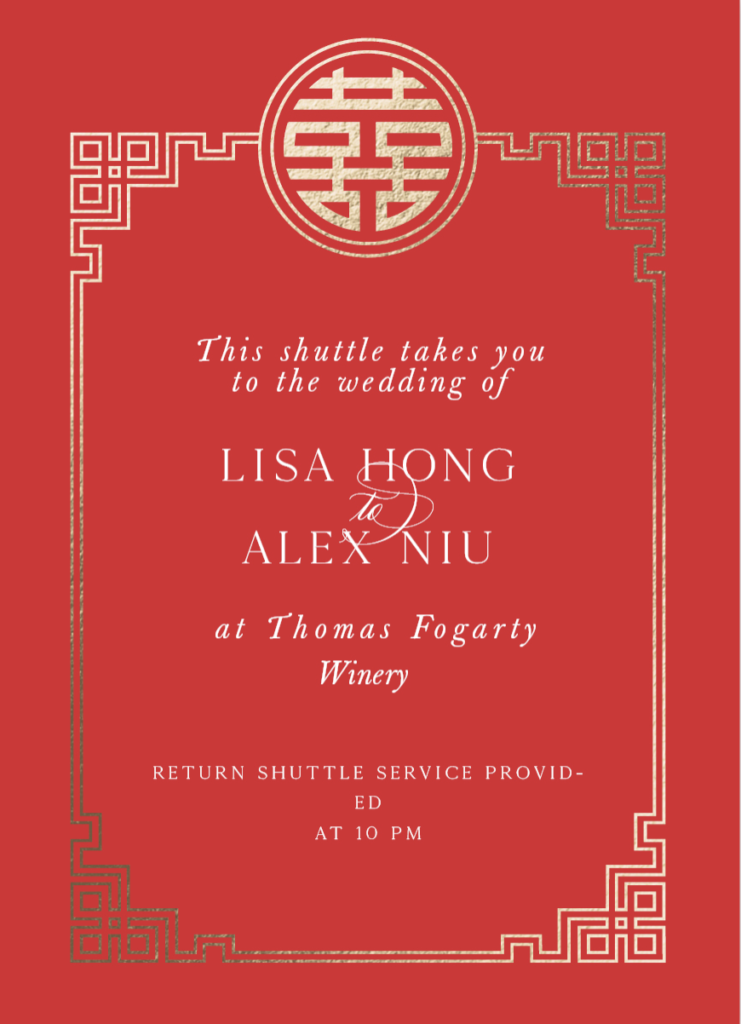

Well… impressed? I hope that’ll give everyone a lot to think about, AND a lot to choose from!
Canyon Ranch – my Discovery of the Year!
Lately, I had to travel to the San Francisco Bay Area for work and needed a hotel to stay. Someone recommended Canyon Ranch in Woodside, and to my great embarrassment, I had not heard of it before despite the fact that I had lived close by for fourteen years. I decided to give it a try – and I am so happy that I did!
Canyon Ranch is different from any hotel I have known so far – it is actually a wellness retreat, geared at the relaxation of body and mind. Hidden behind a dark, solid metal gate, you would never guess what’s beyond: a true oasis of peace and tranquillity with all the creature comforts you can imagine.

The entrance to the hotel already sets the tone: a grey, three-story siding-clad building that literally melds into the surrounding Redwood Forest, respectful to undisturbed nature; a modern, streamlined water feature displaying the hotel name, accompanied by the gentle sounds of splashing water – nothing fancy or frilly that might distract from the simplicity and tranquillity that is the guiding principle of this experience.

My room was located in one of several “tree houses” – small cabin-like structures built right into the forest, some clinging to a steep incline, supported by stilts (like mine) which house two units on top of each other and balconies hovering among the tree tops.

You really feel you are in a tree house. All you hear is birdsong and the rustling of the wind in the leaves. Peace and quiet.

My room itself was an interior design marvel illustrating just that – peace and quiet. Simple shapes, balanced proportions, quiet colors and top-notch materials: all came together to form the perfect cocoon to calm down and relax.

As a designer myself, I was delighted. Every little detail was – just right. A joy for the eye as much as for the soul.

A backdrop of an enormously enlarged wood slice, a comfy bed with down pillows, bedding of all natural materials, a dimmable bedside lamp, a juxtaposition of textures (stingray skin and glass top on the bedside table!) – I could go on and on. I also had a beautiful leather sofa with a cuddly sheepskin cushion – again, clean lines, great comfort and a contrast of textures. The same for my bathroom with a big soaking tub, modern, minimalist fixtures and oh-so-fragrant toiletries…

In the words of Apple founder Steve Jobs: “Simplicity is the utmost sophistication.”
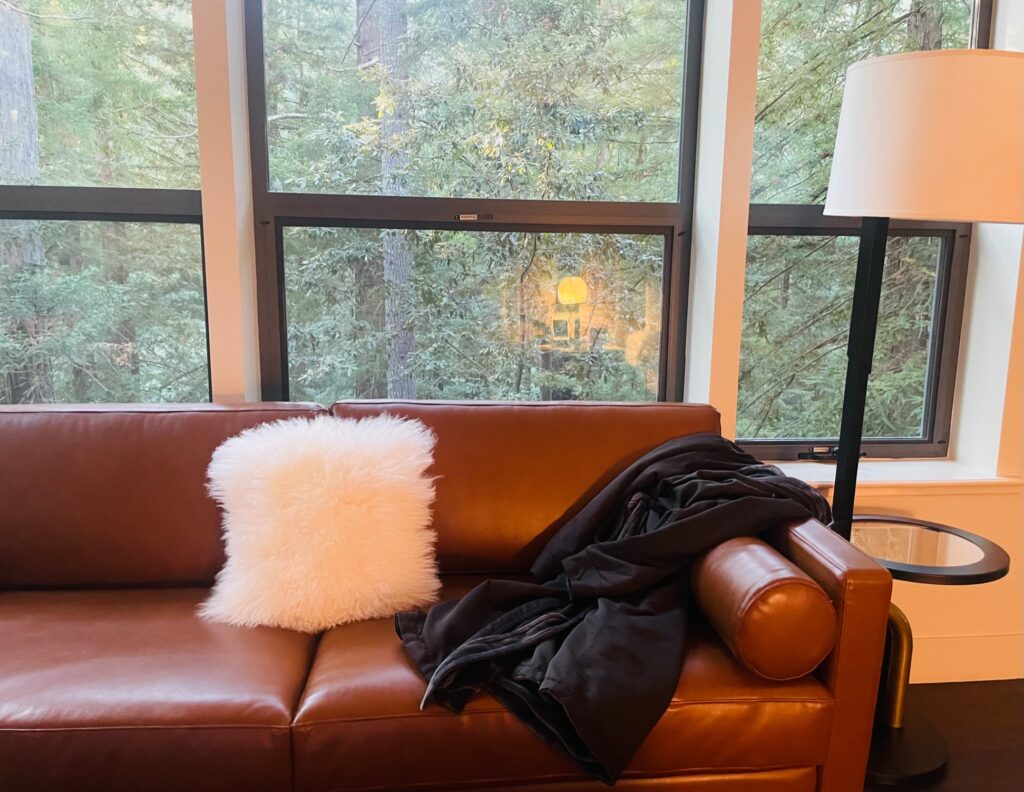
Wrapped up in the most comfortable and soft hotel robe, I did my work lounging with a view of the forest. It was as close to the full retreat experience as I could get!
Then it was dinnertime. Did I already mention that all meals are included? So easy – a short walk to the dining room and terrace in the golden light of the sunset…


Meals are served either on the terrace or in the adjacent dining room; either at a table or while sitting around a fire table (in this case, you’ll dine from a wooden tray on your knees – they’ve thought of everything!) – whatever you feel like. And while I am on a continuous strict diet, I had to relent while at Canyon Ranch: their food is just heavenly, and it would have been a sin not to enjoy it! Food is a big part of the “feel good” experience, and mealtime brings together the guests for leisurely conversation.
A few delicious examples:

Corn ravioli in an artistic presentation…

Maitake mushrooms with greens and nuts…

… everything served in beautiful ceramic bowls in the soothing soft shades of grey that dominate the whole property. Talk of design!!
Next morning, my breakfast was just as fantastic…


I chose the freshly pressed orange juice (best juice I ever had!), coffee and blueberry pancakes…
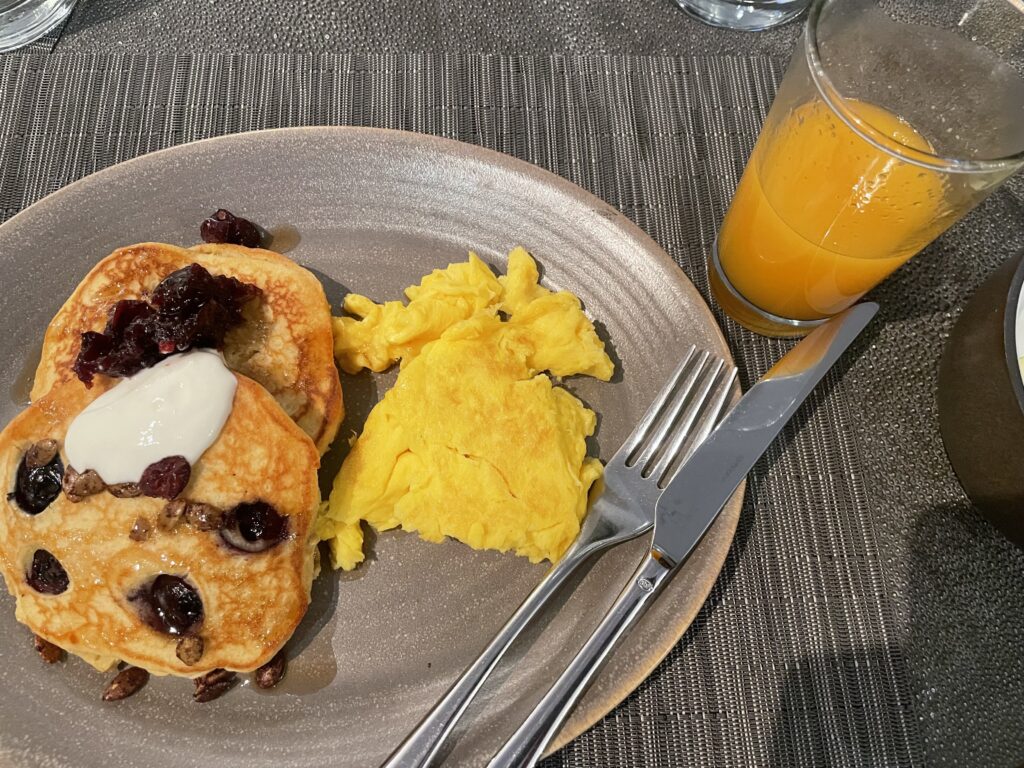

… outside on the patio, with a glorious view. What a way to start the day! The other guests (the ones who did not have to work!) went off to nature hikes, yoga and massages or headed to the state-of-the-art gym. I allowed myself 30 minutes of hard swim in the spectacular pool – after all, I had to work off all those delicious calories, right?!


In short – I loved it. I will definitely be back – but in addition, this would be a fantastic location for an intimate wedding, a quiet bachelorette party, a “Mini Moon,” a spa day (and night) for bride and bridesmaids, and a wonderful place for wedding guests to stay. With 43 guest rooms, Canyon Ranch can definitely accommodate enough out-of-town guests and the newlyweds themselves – with regenerating activities for everyone. Meditation, yoga, painting, fitness, kayaking, Tai Chi, Ikebana – guests will be entertained and at the same time achieve perfect relaxation. There are patios with views of the forest which would be the perfect spot to say “I Do” in an unforgettable setting. The food would be equally spectacular. There would be a wedding cake and dancing. What else could you desire…?
So now you understand why I am calling Canyon Ranch my personal discovery of the year. Do go and experience it yourselves. You will come back a believer, I guarantee it!
Taylor and Sheldon’s Joyful Summer Wedding
Taylor and Sheldon are a busy professional couple, living out of state – and for planning and designing their wedding, they enlisted the help of my company, A Day Like No Other. They had chosen a venue close to where the bride grew up and where her parents are still living: Thomas Fogarty Winery in Woodside. Simply perfect for the garden-themed summer wedding the couple was envisioning, elegant and romantic in ivory and lilac hues, with a few metallic gold accents.
Their invitations set the tone:

The bride and her bridesmaids were getting ready at the house of the bride’s parents, with hair and makeup services by Aqua Beauty Lounge.

A timeless mother-daughter moment…
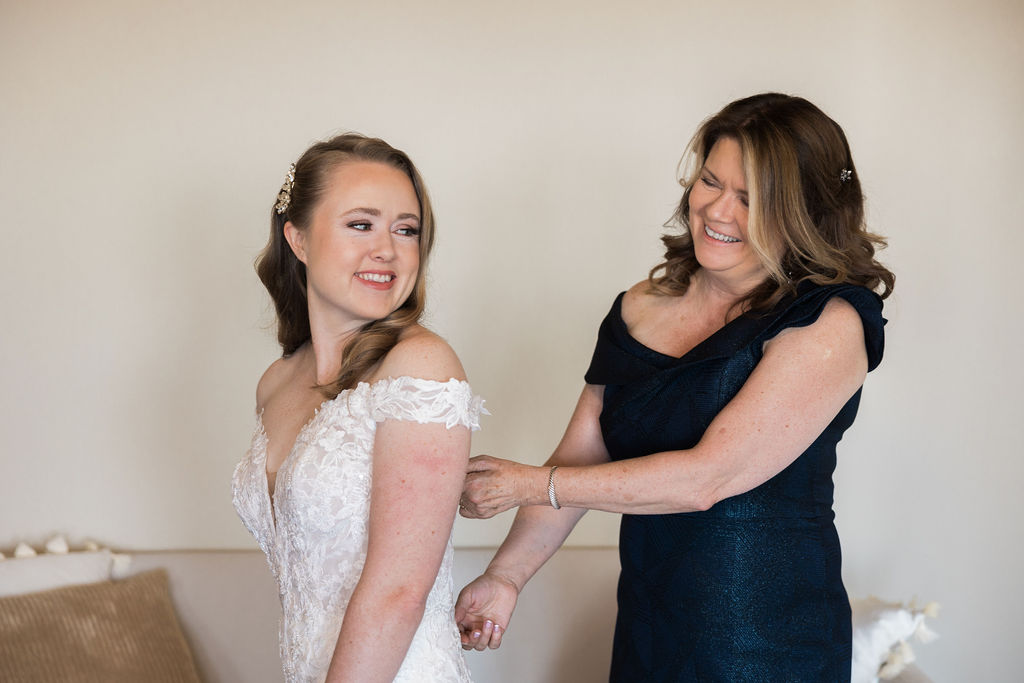
Not to forget the jewelry…

And here she is… dramatic!


Lastly – the bridal bouquet (all florals by Laurel & Vine):

And with that, Taylor was ready to present herself to her husband-to-be.
Sheldon had meanwhile also dressed up…



…. and was ready for the “First Look.”


Always such a touching moment…
Time for many, many photos with photographer Kevin Chin and for video with videographer Martin Meyer!


Official wedding photo, right?
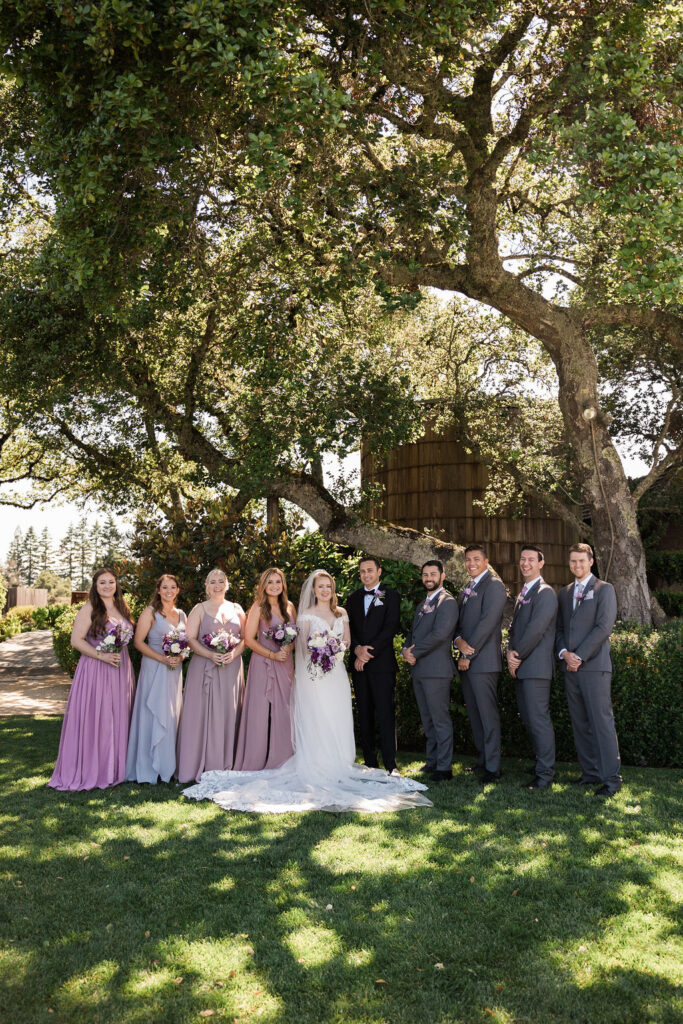
Meanwhile, the ceremony area had been set up, officiant Chris Thielen had arrived, and DJ Paul Burchfield of Big Fun Disc Jockeys had the music going as guests began to arrive (via shuttles from Corinthian Ground Transportation). It was the perfect summer day, warm and sunny under a cloudless blue sky, and with a slight breeze.

The ceremony lawn offers endless views, from the San Francisco skyline all the way to Silicon Valley.

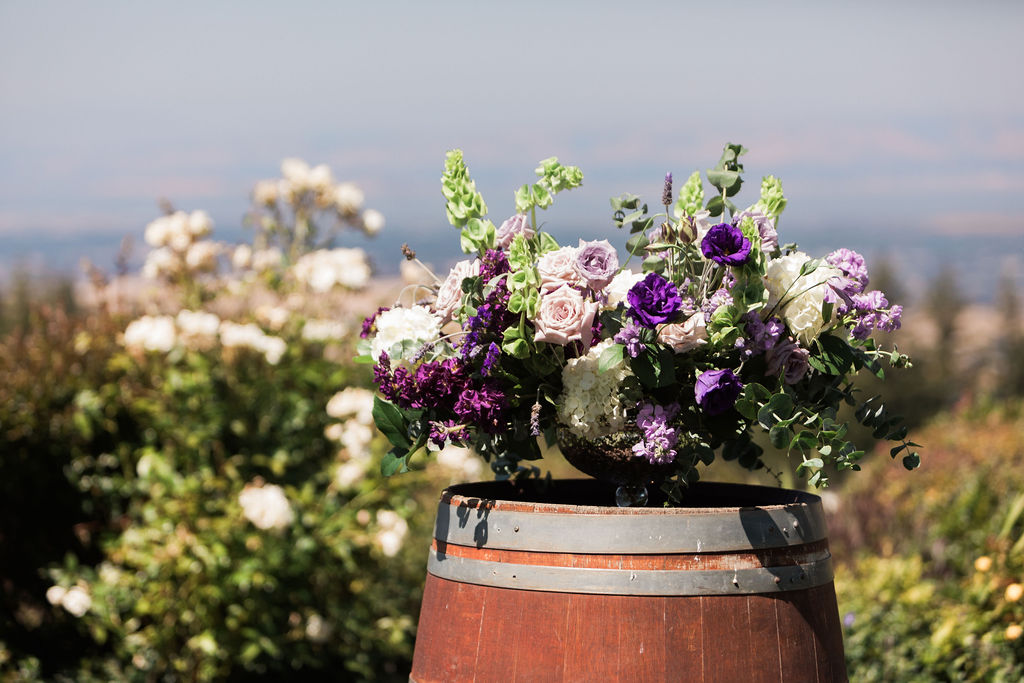
And here comes the bride, on her father’s arm.


After her father formally “gave her away” to Sheldon, Taylor joined him and officiant Chris Thielen for the ceremony.


Ring exchange…

… and “You may now kiss your bride!”

Just married!! And off to many more photos and video …

… while guests enjoyed Fogarty wines and hors d’oeuvres (all food and bar services by Melons Catering) on the open Deck at Fogarty Winery.


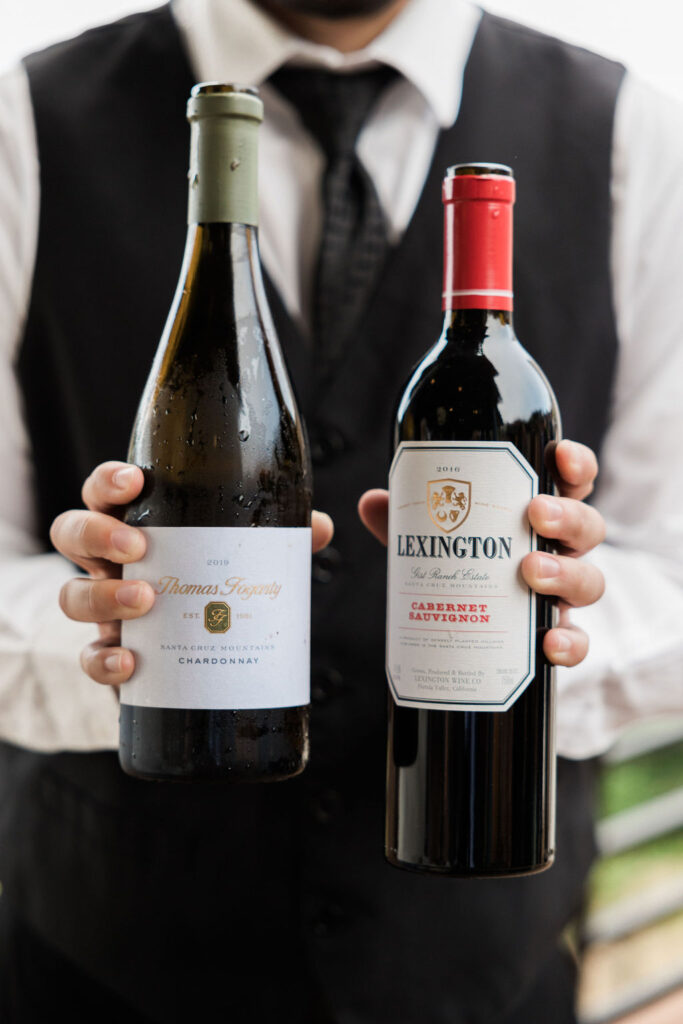
The Melons Catering team had meanwhile set up dinner in the open Pavilion…

… with elegant china, placemats, glassware and cutlery from Hensley Event Resources, on beautiful linens by Napa Valley Linens.

Impressive centerpieces (by Laurel & Vine) were the stunning focal point of each table.
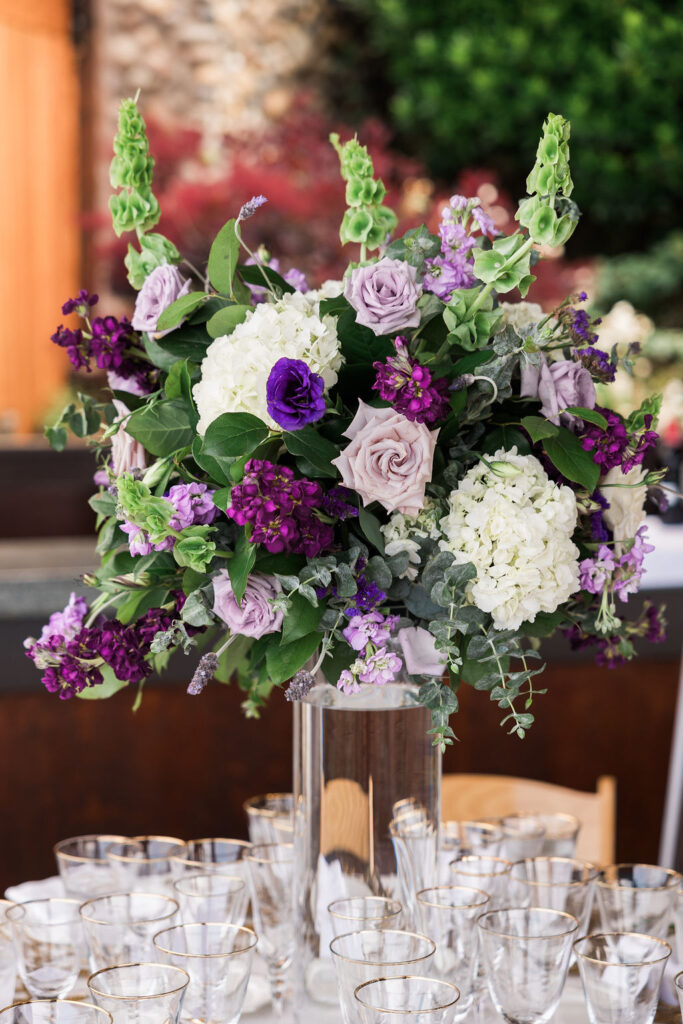

All elements had been carefully chosen to complement the overall look of summery elegance and luxury – including the seating chart for guests…

… and beautifully packaged favors in the wedding colors.


The Head Table, of course, got extra-special treatment!
After a delicious dinner (by Melons Catering)…

and many toasts and speeches…

… AND a group photo with all their guests…

… it was definitely time for dancing and for cutting the cake (by Susie Cakes)!

The newlyweds completed this time-honored first task in their marriage with bravura.

For her choreographed First Dance, the bride had changed into an “easier” (but no less stunning!) dress…


Applause!! Next up – Bouquet Toss…
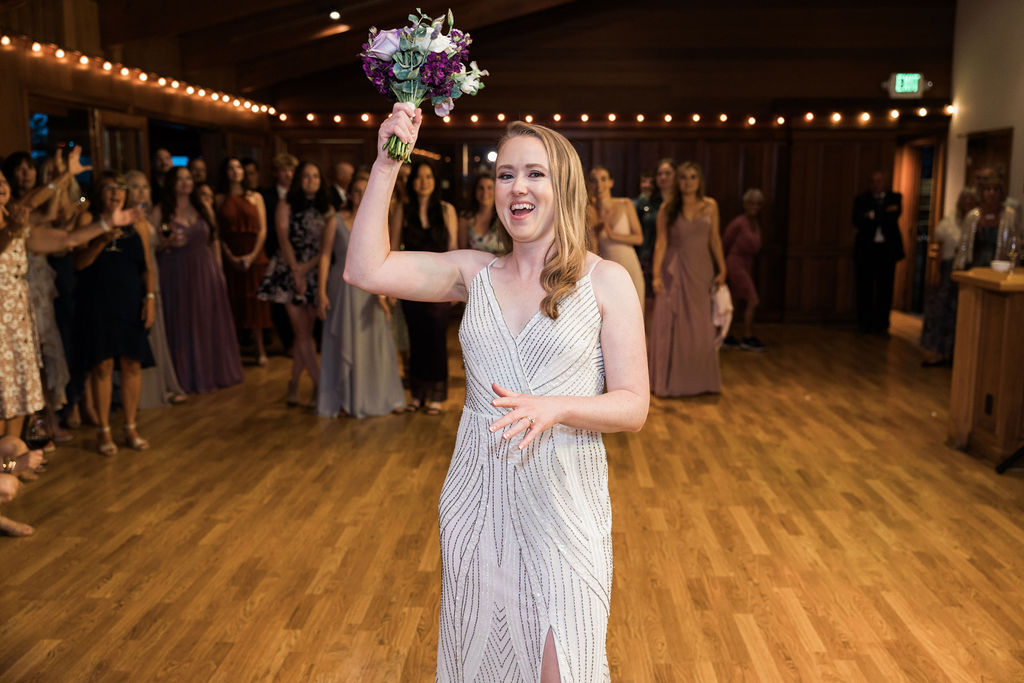
… and Garter Toss!

And what followed then, was a truly EPIC dance party!

What a celebration! Our best wishes on your way, Taylor and Sheldon!
